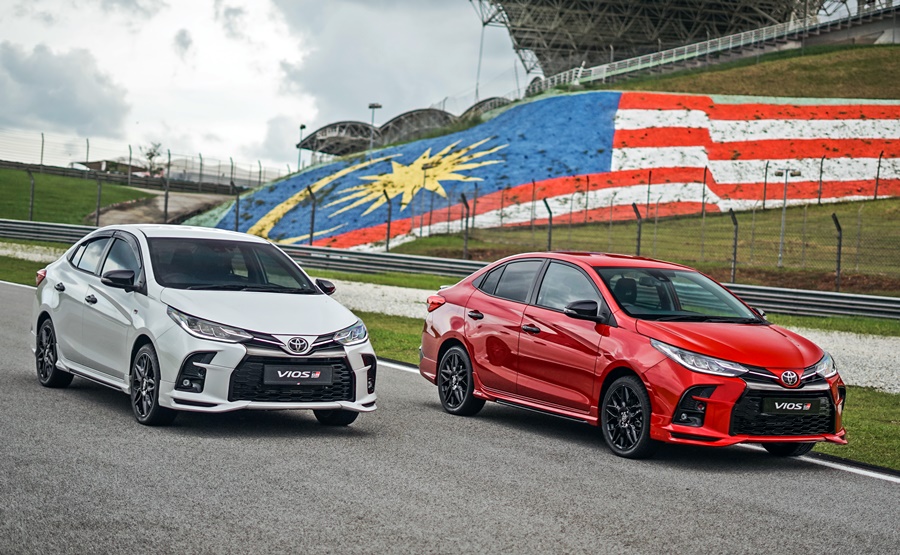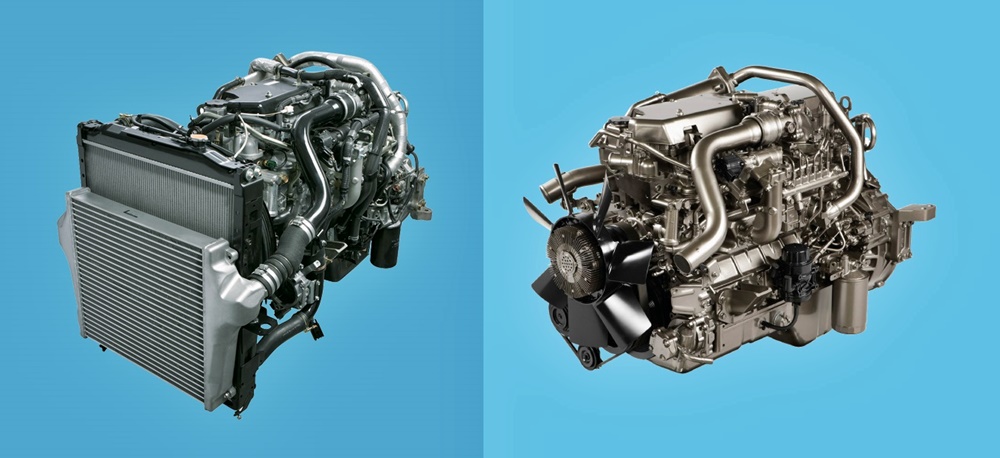UMW Toyota Motor (UMWT) reports strong growth in sales for the first quarter (Q1) of 2021. The Toyota/Lexus importer and distributor said the total number of new Toyota and Lexus vehicles sold in the first 3 months of the year were more than 17,000 units with a market share of approximately 12.1%, an increase of 62% year-on-year compared to the sales volume for the same period in 2020.
Commenting on the achievement, UMWT’s President, Ravindran K., said: “During the first quarter of 2020, the market was already declining due to the pandemic. This year, it’s a different story; with the situation easing as well as the support by the government through the PENJANA program that exempts sales tax partially or fully until June 30 this year, new vehicle sales have been consistently high. In fact, for Toyota, our momentum started in December when we launched the Toyota GR Yaris and Vios GR-Sport which excited the market and set a positive note to enter 2021.”
Bestselling models
The bestselling models were the Vios and the Hilux, the latter being the market leader, accounting for approximately 56% of the pick-up truck market in the first quarter. The updated versions of the Innova and Fortuner were also introduced early in the year with new styling and extra value-added features.

The Yaris hatchback has been consistently leading in its Non-National hatchback segment with Q1 estimated market share of 73%. Meanwhile, the Vios and sportier Vios GR-Sport (GR-S) version saw approximately 5,600 units sold since their launch. With the addition of the sporty, enhanced performance GR-S, the appeal of this model is expected to increase. Furthermore, the Vios Challenge One-Make Race Series that is now in its fourth season has left a strong impression on the public with regards to the dynamic side of the model.
GR Yaris sales exceeded expectations
Sales of the GR Yaris, imported from Japan, exceeded expectations. Most of the units allocated for the Malaysian market (out of 25,000 units for worldwide sales) were booked within a month of launch. The strong response mirrored that in other markets as enthusiasts could not resist owning the competition-ready hatchback that has the world’s most powerful 3-cylinder engine (261 bhp/360 Nm) and the lightest and smallest 1.6-litre turbo unit currently in production.
The GR Yaris (above) is one of three models in Toyota’s high-performance GR brand which are available in Malaysia. The other models are the GR Supra and Vios GR-Sport. These models are exclusively sold through dealerships with the GR Garage that is dedicated to the brand.
Early response to the all-new Toyota Corolla Cross launched in March indicates that it is a winner. With the strong demand, UMW Toyota Motor has been encouraged to consider local assembly of the model to increase available stocks and this could happen by the end of 2021.
“Malaysia has seen strong Toyota sales this year due to improving conditions of the pandemic. With our wider line-up of models and exciting offerings, we are confident that our sales volume will grow steadily this year and certainly exceed the volume recorded in 2020. As always, we thank our loyal customers and also welcome those who are owning a Toyota for the first time,” said Akio Takeyama, Deputy Chairman of UMW Toyota Motor.

Promotions for Hari Raya
With the Hari Raya festive season coming up during the second quarter, UMWT will be running the ‘Countless Rewards’ promotion, encouraging purchases to be made before the sales tax exemption period ends on June 30. The exemption is not only for locally assembled models but also imported ones such as the Alphard, RAV4, GR Supra and Camry.
Financing schemes available include the EZ Beli scheme which offers customers low instalments (depending on the model). Additionally, savings are available with Toyota Service Savers which provides owners lower maintenance cost of their vehicles.
UMW Toyota Motor introduces Toyota Synergised Mobility to present a new aspect of the brand

How long do you think it takes to glance at a SMS (text message on your mobilephone) when you’re driving? One second? Two seconds? You’re not alone. Most drivers believe that texting and driving creates only a momentary distraction. This week, Lexus in the USA has released a new video to shatter this common misconception. The average length of time it actually takes to send or receive a text message when you’re behind the wheel is 4.6 seconds, according to the US National Highway Traffic Safety Administration (NHTSA).
Driving for 4.6 seconds with eyes closed
The company’s initiative is in support of national Distracted Driving Awareness Month, established by the American National Safety Council (NSC) more than 10 years ago. Distracted driving is dangerous, claiming 3,142 lives in 2019 (the most recent available data) in America, according to NHTSA. Texting is the most alarming distraction: at about 90 km/h, taking your eyes off the road for 4.6 seconds is like driving the length of an entire football field – with your eyes closed.
In the video called “Driving Disrupted,” Lexus demonstrates exactly what happens when drivers can no longer see the road for 4.6 seconds. Participants get behind the wheel of a Lexus NX on a closed course, thinking they’re taking SUV for a routine test drive. What they don’t know is that they’re not driving an ordinary NX. They’re driving a one-of-a-kind specially modified vehicle called the NX 4.6. It’s equipped with electrochromic technology that turns the windscreen and windows from transparent to opaque instantaneously, completely obscuring the driver’s view for 4.6 seconds. The video captures the chaos that ensues.
“Lexus wants to bring awareness to safety behind the wheel by changing perceptions about texting and driving,” said Vinay Shahani, Vice-President of Lexus marketing. “Even the most advanced safety systems on the road today can’t replace the undivided attention of the driver.”
In Malaysia, under Rule 17A, LN166/59, a motorist will be subject to fines of up to RM1,000, or jail time of up to 3 months. Second-time offenders are subject to fines of up to RM2,000, and/or jail time of up to 6 months. The offence has been considered a non-compoundable offence since the middle of 2020, and offenders will be required to make a court appearance before a magistrate to settle individual cases. Compoundable offences have the provision where the motorist, in admitting guilt, is allowed to pay a specific fine without having to go to court.
About electrochromic glass
By the way, about that electrochromic technology for the glass. It’s like the photochromic sunglasses that darken in strong lighting conditions but more advanced for use in cars. There are various technologies for this, among them using a small electrical charge (at the press of a button) to move lithium ions so that the glass is either light or dark. It therefore eliminates the need to add tinting film.
Electrochromic glass is appearing in more new models, mostly of premium brands as the technology is still fairly new (to the auto industry) and therefore expensive. Over time, like laminated glass which does not shatter when hit by a stone, prices should drop and the glass will be offered in lower-priced models.
Even before GMC’s electric HUMMER supertruck goes on sale at the end of this year, the company has revealed another model – the HUMMER EV SUV – which will make its debut in 2023. The SUV is the next chapter in the company’s revival with only EV products.
“The GMC HUMMER EVs were envisioned to be the most capable and compelling electric supertrucks ever,” said Duncan Aldred, Global Vice-President of Buick and GMC. “The new HUMMER EV SUV is the next chapter, which will offer many options for customers to tailor the truck to their lifestyles, while continuing to encourage them to forge new paths with zero emissions.”
Starting with Edition 1
Driven by General Motors’ next-generation Ultium Platform, the new EV SUV will launch with an exclusive Edition 1. This will give the customer a choice to equip the vehicle for optimal driving range or maximum off-road capability. As standard, the Edition 1 will have 22-inch premium wheels, assist steps and floorliners.
Customers will be able to opt for the Extreme Off-Road package with 18-inch wheels and 35-inch-OD MT tyres, underbody armour and rock sliders, a front eLocker and virtual rear lockers, heavy-duty ball-spline half-shafts, UltraVision with underbody camera views and other high-tech features.
The SUV’s look is rugged, like the pick-up truck, but has a different rear design with a full-size spare tyre mounted in the classic SUV fashion. Inside, a similar 5-passenger layout from the pick-up remains and includes a large and useful rear cargo area.
Crabwalk and Extract Mode
GMC is highlighting the superior capabilities of the new SUV while are possible with the HUMMER EV’s signature features such as CrabWalk, a revolutionary setting utilizing 4-wheel steer to drive diagonally at low speeds – like a crab. This will give a capability no other competitive SUV can offer. There is also Extract Mode which is a first-of-its-kind system that makes full use of the Adaptive Air Suspension to raise the vehicle about 150 mm to get over tough obstacles. This is extra ground clearance in addition to the already tall ride height.
Although it has a 3220 mm wheelbase, it can turn within 10.8 metres with 4-Wheel Steer. Impressive departure and breakover angles also allow it to be driven up and down steep slopes without difficulty.
An immersive interior puts the driver at the centre of every moment, including customizable, multisensory user features and an open driving experience with the standard Infinity Roof with removable Sky Panels, I-Bar and rear drop glass.
830 hp, 15,592 Nm
GM’s Ultium Drive System offers up to 830 horsepower and up to 15,592 Nm of torque (GM estimated) — enough power for super-fast 0 to 96 km/h sprints in a time claimed to be approximately 3.5 seconds. The 20-module Ultium battery system can take the vehicle up to a 48 kms, GM engineers estimate, on the Edition 1 (with standard equipment).
Additionally, all HUMMER EV SUV models will feature the enhanced version of Super Cruise, an optional driver-assistance technology offering hands-free driving on more than 320,000 kms of enabled roads, and a new automatic lane-changing feature, where the system can determine when a lane change is optimal and initiate the manoeuvre, while following signaling protocols.
Production and pricing in 2023
Production will begin in early 2023, and GMC is able to indicate the starting price of the Edition 1 which will be US$105,595 (about RM436,265 at today’s exchange rate). When equipped with the Extreme Off-Road Package, the starting price will be about 4.7% more.
The Hummer returns… as an EV supertruck with 1,000 horsepower (w/VIDEO)

Caterham Cars is no longer owned by Malaysians Tan Sri Tony Fernandes and Datuk Kamarudin Meranun (who became owners in 2011), having been acquired by VT Holdings of Japan. The automotive group, which has been the importer for the Seven since 2009, assumes custodianship of the legendary British sportscar brand which is almost 50 years old.
VT Holdings currently sells over 120 cars annually and is one of Japan’s largest retailer groups with over 200 showrooms nationwide. It also has investments in the UK, Spain, Thailand and South Africa, and imports two and four-wheeled brands such as Royal Enfield and Lotus for the Japanese market.
Motorsport, and the global track-day communities, have always played a central role in Caterham’s commercial success. The brand now joins a group led by Chief Executive Kazuho Takahashi, who shares the same passions, having raced competitively in JGTC, Super GT and Super Taikyu championships for the past 20 years.
Commenting on the acquisition, Mr. Takahashi said: “VT Holdings is proud to welcome Caterham to the group. We have not only purchased a globally renowned performance car manufacturer but become custodians of a motoring legend. We will protect and develop the Seven to meet the legislative challenges that lie ahead.”
Caterham Cars began as a Lotus 7 dealer during the 1960s and when Lotus discontinued the model, the dealer, Graham Nearn, purchased the rights to continue using the Seven design and made the cars in a small volume. The Seven has remained popular and highly regarded by car enthusiasts.
Caterham Cars today exports to 20 markets globally with exports accounting for 60% of its annual new car sales volume.
Malaysian retail giant MR D.I.Y. Group (M) Berhad has 700 stores across the country and logistics to support the stores requires reliable transport which is also fuel efficient. Having already used a number of Isuzu vehicles since 2017 and found them to meet the demands of the business, the company has steadily increased its fleet size with vehicles from the same brand which was the No. 1 truck brand in Malaysia in 2020 and earlier years.
Recently, MR D.I.Y. tool delivery of another batch of 8 Isuzu medium-duty trucks to add to its fleet. The trucks are from the F-Series (Forward Series) range, comprising 6 units of the FSR90 model and 2 units of the FVR300 model.
A handover ceremony with a mock key presentation marked the official delivery of the new Isuzu trucks was held recently at MR D.I.Y.’s headquarters in Seri Kembangan, Selangor. Making the delivery personally were the senior management teams of Isuzu, MR D.I.Y. and Ultra Gallant, the authorised Isuzu dealer serving MR D.I.Y.
“We are very pleased to have completed the delivery of 8 units of Isuzu medium-duty FSR90 and FVR300 trucks to our esteemed customer, MR D.I.Y., and to be able to continuously provide the support they require to operate their flourishing logistical assignments. We would like to thank MR D.I.Y. for the support and trust given to the Isuzu brand,” said Koji Nakamura, CEO of Isuzu Malaysia.
Providing maximum efficiency and productivity
“As one of the largest Japanese truck manufacturers globally, it is our obligation to provide our customers with commercial vehicles that can lead the way forward for their business to achieve maximum efficiency and productivity,” he added.
Mr. Nakamura said that both of the models are part of Isuzu’s F-Series medium-duty commercial vehicles that the company has been producing for decades with continuous development of new trucking innovations, and where its customers around the world embrace and count on for the advance features, innovative design, and dependable performance.
“The Isuzu FSR90 and FVR300 medium-duty trucks are the ideal, adaptable, and value-added choice for meeting the requirements of any transport assignment. With the gross vehicle weight of 11,900 kgs for FSR90 and 19,000 kgs for FVR300, we are confident the trucks will be able to provide high utilization with absolute productivity, reliability, and safety for the sustainability of MR D.I.Y.’s soaring business,” said Mr. Nakamura.

5 powertrain choices
“Isuzu’s F-Series range of commercial vehicles feature a choice of 5 powertrains for a range of performance and torque, optimized wheelbases for greater load capacity and body-mounting capability, offering the versatility today’s businesses need to be successful,” he added.
MR D.I.Y. purchased its first Isuzu truck in 2017 and has been steadily adding more units to its fleet over the last 4 years. With this latest addition, the company now has a total of 100 units of Isuzu trucks in its fleet.
Commenting on the handover of the vehicles, a MR D.I.Y. spokesperson said: “We are on a strong growth trajectory, with 700 stores now, and have plans to open 175 new stores across our 3 brands in 2021. The backbone of our growth is the efficient distribution of goods via our centrally-managed distribution system. Isuzu has been a valued long-standing partner who well understands our needs, and has been supportive in meeting them.”
To know more about the commercial vehicles available from Isuzu Malaysia or to locate an authorised dealership in Malaysia, visit www.isuzu.net.my.